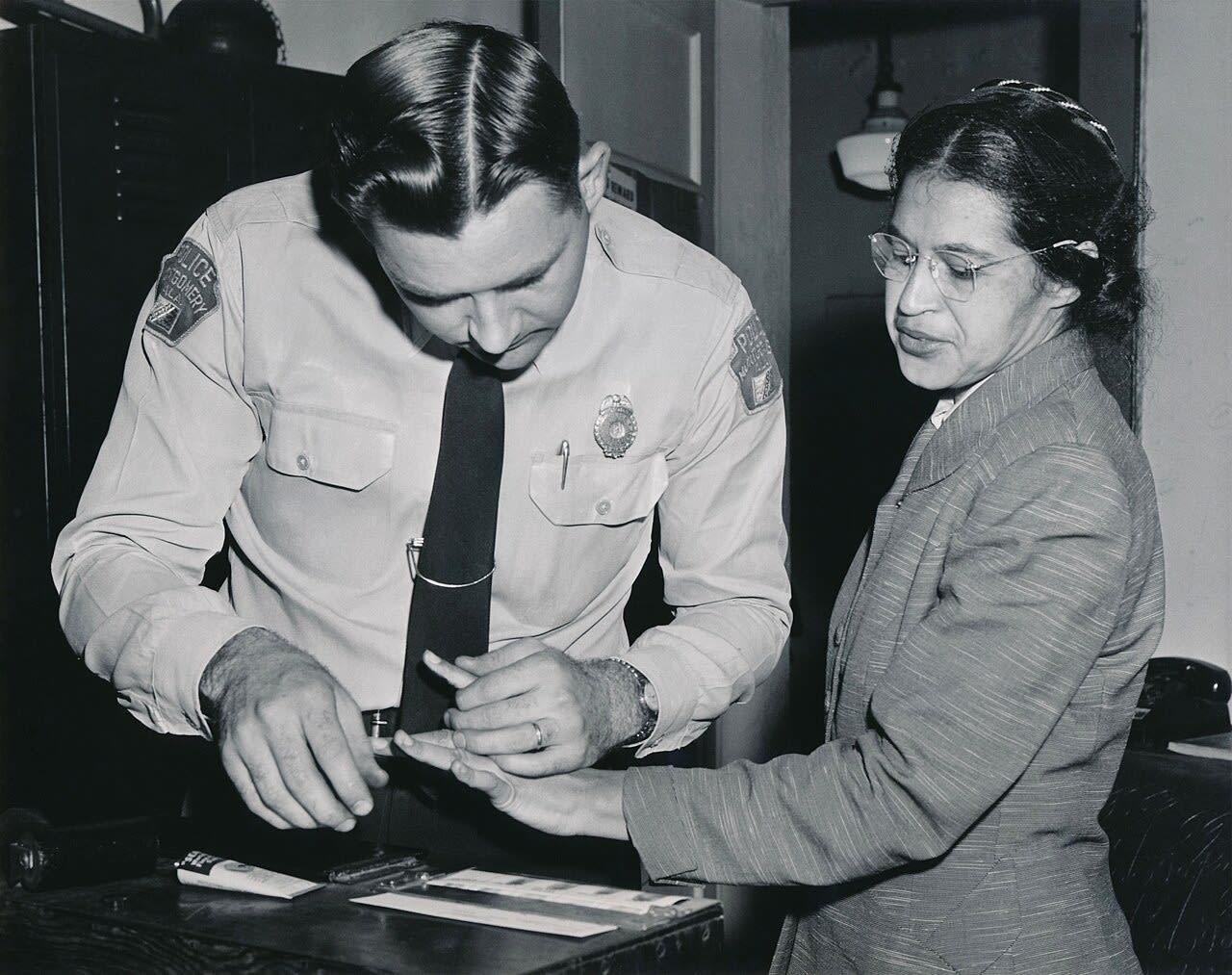
In Empire, American realist painter & printmaker Robert Cottingham depicts the iconic Empire Theater in Montgomery, Alabama. The composition crops in on the theater’s facade to frame the business name on the front of the building's marquee. It reads, “Empire.” The subject matter is the usual fare for Cottingham, who has become renowned for depicting neons, building facades, marquees, and other elements of traditional American architecture. But beneath Cottingham’s unassuming homage to American architectural design lies a reference to the site where the Civil Rights Movement began and a broader exploration of America’s relationship to its history.

ROBERT COTTINGHAM | (Detail) Empire, 2008. Serigraph, 32 5/8 x 46 1/4 in (82.9 x 117.5 cm)
On December 1st, 1955, several white passengers boarded a bus outside the Empire Theater in Montgomery, Alabama. The bus driver instructed all "colored" folks riding the bus to vacate their seats for the boarding white passengers. Rosa Parks—then secretary to the president of the Montgomery chapter of the NAACP—refused to vacate her seat. Police arrested Parks for defying the bus driver's orders. Though not an uncommon occurrence for the racially segregated American South, this prejudiced arrest sparked a series of boycotts and protests against racial discrimination that directly led to the Civil Rights Movement—This is the backstory of Cottingham's composition.
 Lieutenant D.H. Lackey (left) fingerprints Rosa Parks (right) for her involvement in the Montogemery Bus Boycott that followed her initial arrest for refusing to give up her bus seat to a white passenger. February 22, 1956.
Lieutenant D.H. Lackey (left) fingerprints Rosa Parks (right) for her involvement in the Montogemery Bus Boycott that followed her initial arrest for refusing to give up her bus seat to a white passenger. February 22, 1956.
Cottingham’s composition of the Empire Theater is photorealistic but minimalistic in its inclusion of contextualizing detail. Aside from the word “Empire” and a collective understanding of what a marquee is, there is little indication of what Cottingham depicts or why. Flat expanses of color typical of serigraphs dominate the composition of Empire, which make the work feel emotionally sterile. What can the viewer make of this inanimate facade and the word “Empire”? The answer may lie in Cottingham’s fascination with American cultural myths.
As a professionally-trained, now-retired advertising man, Cottingham would have been hyper-aware of how visual design affects human psychology. Curiously, however, Empire is free of any gimmicks that might rouse our emotions, which leaves viewers free to contemplate the significance of the word “Empire” outside of its immediate semiotic and geographic context—Similar in execution to the text based work of Jasper Johns—Some viewers appreciate the sleek typography; some see an ode to the glamor of American architecture; others pick up on an allusion to America’s imperialist economic policies and slavery; while those old enough to have lived through segregation immediately recognize Empire as a surgical excision of an unofficial monument of America’s history.
In 1997, the city of Montgomery demolished the Empire Theater to make way for the Rosa Parks Memorial Library. While hundreds of pictures of the Theater exist because of its historical significance, Cottingham's depiction of the building remains unique in its ability to faithfully capture the Theater as a tangible place, a historically significant location, and an abstracted symbol of America’s aetiological myths. In the current cultural climate, many Americans believe we live in a post-racial society. Yet, Rosa Parks, the woman who arguably sparked the revolt against racial discrimination, passed away in 2005—Cottingham's Empire, with its flat planes of color, historical allusions, and predominant stillness, evokes the feeling that America's understanding of its not-so-distant past is more melancholic pretense than truth.
About the Artist
Robert Cottingham (b. 1935) is one of the most important painters of American realism living today. Like Andy Warhol—who Cottingham has cited as a significant influence on his work—he is noted for his use of advertising design techniques, such as cropping, to disassociate objects from their assumed contexts. His work has been exhibited by numerous institutions, including the Whitney Museum of American Art and the Smithsonian American Art Museum. Brooklyn-born, Cottingham now works and lives in Connecticut.

ROBERT COTTINGHAM | (Detail) Empire, 2008. Serigraph, 32 5/8 x 46 1/4 in (82.9 x 117.5 cm)

ROBERT COTTINGHAM | (Detail) Empire, 2008. Serigraph, 32 5/8 x 46 1/4 in (82.9 x 117.5 cm)

ROBERT COTTINGHAM | (Detail) Empire, 2008. Serigraph, 32 5/8 x 46 1/4 in (82.9 x 117.5 cm)
